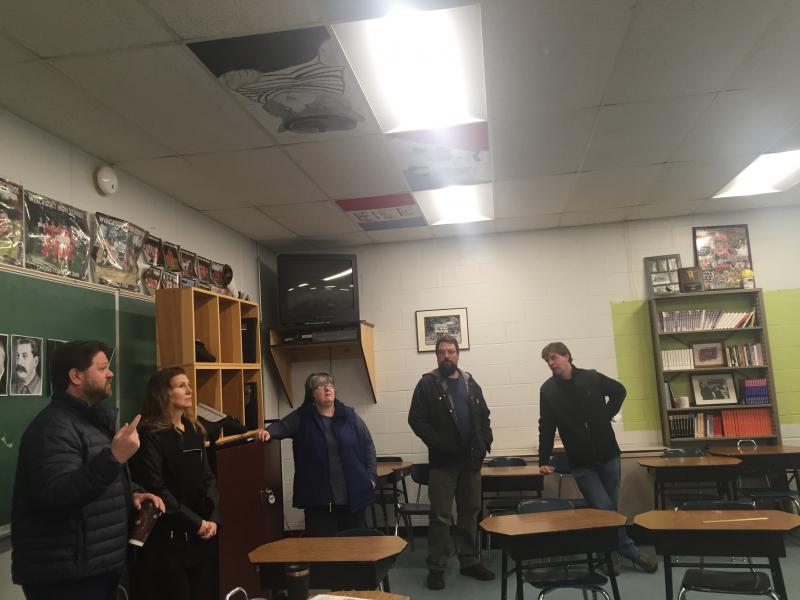Merry: project ‘kind of a no-brainer’
 Wiscasset Town Manager Marian Anderson, center, looks up to an LED light installed as a mock-up in a Wiscasset Middle High School classroom. School department buildings would get 2,000 new lights under the energy project. At left are School Committee Chairman Michael Dunn and wife Lenore. SUSAN JOHNS/Wiscasset Newspaper
Wiscasset Town Manager Marian Anderson, center, looks up to an LED light installed as a mock-up in a Wiscasset Middle High School classroom. School department buildings would get 2,000 new lights under the energy project. At left are School Committee Chairman Michael Dunn and wife Lenore. SUSAN JOHNS/Wiscasset Newspaper
 Wiscasset Town Manager Marian Anderson, center, looks up to an LED light installed as a mock-up in a Wiscasset Middle High School classroom. School department buildings would get 2,000 new lights under the energy project. At left are School Committee Chairman Michael Dunn and wife Lenore. SUSAN JOHNS/Wiscasset Newspaper
Wiscasset Town Manager Marian Anderson, center, looks up to an LED light installed as a mock-up in a Wiscasset Middle High School classroom. School department buildings would get 2,000 new lights under the energy project. At left are School Committee Chairman Michael Dunn and wife Lenore. SUSAN JOHNS/Wiscasset Newspaper
In the Wiscasset Middle High School lobby Saturday, Sarah Joyce, Wiscasset parent and taxpayer, said she was there to learn about the school department’s proposed energy project and how it would better students.
About an hour later, at the end of the WMHS part of the two-school tour, Joyce said, “I think the lighting (work) is hugely significant, but I think the heating will be a huge benefit as well.”
Facilities and transportation director John Merry led Joyce and the rest of the turnout of about 20 parents, children and other residents, along with school and town officials and a Siemens representative, through the halls and some of the classrooms of both the 1960s and 1970s parts of WMHS. He pointed out windows’ spray-foam insulation he said was doing its best; science lab vent hoods that only work when both are running, even if only one is in use; and heating and air units whose controls have gone out of control.
Merry said not only does that make rooms colder or warmer than they should be, it can also keep them from dropping to the weekend setting of 65 F. Other equipment is being used to override units’ controls, but it’s not efficient, he said.
Merry got “wow’s” from some attendees when he led the group from a classroom with the longtime, yellow T-12 lighting into an adjacent one where Siemens had installed LED lighting to compare it to. Some attendees’ mouths were open as they continued to look up and around at the room’s appearance with the new white lighting.
The department held one other set of tours early in the evening Jan. 18. Superintendent of Schools Heather Wilmot said Saturday, the higher turnout of parents and families that morning was why she wanted to offer the second round on a weekend. “I’m so glad we did.”
Wilmot said the Jan. 18 tours drew seven community members as well as school committee members Glen Craig and Jason Putnam. The two men also took Saturday’s tours along with Chairman Michael Dunn. During the WMHS one, Craig asked Merry to tell again about the two schools’ monthly electric bills under the schools’ current systems.
At the 72,000-square-foot middle high school, $1,500 of the $3,790, December 2016 bill was a surcharge due to the extent of the electrical damand, Merry said. For the same month at the 53,000-square-foot Wiscasset Elementary School, he didn’t have the total bill amount with him, but $1,200 of it was a demand charge, he said.
He and Wilmot anticipated the demand charges would at least shrink after the project. The savings that would result were not part of the savings projections built into the project the department has planned with Siemens, the two said.
“I think this project is kind of a no-brainer ... a significant upgrade and at a reasonable cost,” Merry said.
Responding to a reporter’s question as he headed back through WMHS for the other stop at WES, Selectman Jeff Slack said of the project, “I think it’s time. Absolutely.”
Town Manager Marian Anderson was also among the morning’s attendees. She said she wanted to have all the correct information. “So I think it’s important to come and find out what’s going on.”
At WES, Dunn’s wife Lenore asked if the yellow lighting would be gone from the gym. It would, Merry said, to some cheers from the group.
Event Date
Address
United States






















